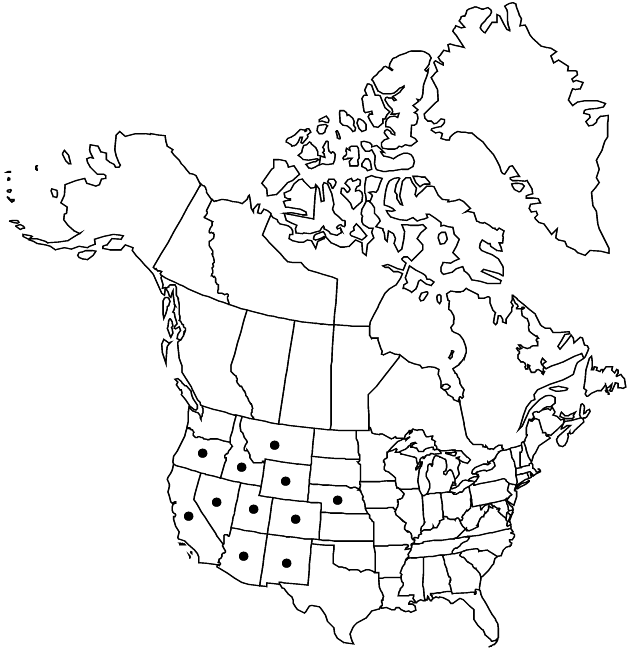Ericameria parryi
Phytologia 75: 88. 1993.
Plants 10–100 cm. Stems ascending to erect, greenish when young becoming tan and gray, sometimes fastigiately branched, densely white to grayish tomentose, eglandular. Leaves (sparse to crowded) erect to ascending or spreading; blades linear to spatulate (plane or concave), 10–80 × 0.5–8 (–14) mm, midnerves (sometimes + 2 laterals) evident, apices acute, faces glabrous or gray, greenish, or yellowish tomentose, sometimes viscid, sometimes gland-dotted or stipitate-glandular; axillary leaf fascicles absent. Heads usually in congested, racemiform or cymiform clusters, sometimes grouped in paniculiform or thyrsiform arrays, sometimes borne singly. Peduncles 1–10+ mm (bracts 0–3, transitional from distal leaves to phyllaries). Involucres subcylindric, 9–18 × 4–8 mm. Phyllaries 10–20 in 3–6 series, tan, ovate to lanceolate or elliptic, 5–11+ × 0.7–2 mm, subequal, mostly chartaceous, sometimes herbaceous-tipped, midnerves mostly evident, (margins narrowly membranous, entire, mostly tomentulose, rarely eciliate) apices acuminate to attenuate, abaxial faces usually tomentose, sometimes resinous. Ray-florets 0. Disc-florets 5–20; corollas 8–12.5 mm. Cypselae tan, narrowly ellipsoid to subturbinate, 3–8 mm, sericeous; pappi off-white to brown, 3.3–7.5 mm. 2n = 18.
Distribution

Ariz., Calif., Colo., Idaho, Mont., N.Mex., Nebr., Nev., Oreg., Utah, Wyo.
Discussion
Varieties 12 (12 in the flora).
Ericameria parryi is widespread, often abundant, and variable (some authors recognize additional varieties). It is reported to hybridize with E. nauseosa. This treatment is based largely on the extensive research on Ericameria and related taxa by L. C. Anderson (1986).
Selected References
None.
Lower Taxa
Key
| 1 | Heads 1–2(–4) at branch tips; leaves sparsely to densely tomentulose (2800–3700 m, California, Nevada) | Ericameria parryi var. monocephala |
| 1 | Heads (2–)4–20+ in cymiform, racemiform, sometimes branched and paniculiform or thyrsiform, arrays, sometimes in terminal glomerules, if heads 1–2, leaves glabrous, viscidulous (var. montana); leaves glabrous or hairy (often tomentulose to tomentose) | > 2 |
| 2 | Leaves oblanceolate, 5–14 mm wide (Califor-nia) | Ericameria parryi var. latior |
| 2 | Leaves linear, linear-spatulate, oblanceolate, or spatulate, 0.5–5 mm wide | > 3 |
| 3 | Leaves abundantly stipitate-glandular (never glabrous or otherwise hairy; California, Nevada) | Ericameria parryi var. aspera |
| 3 | Leaves glabrous or tomentulose to tomentose, usually eglandular, sometimes viscidulous or sparsely or minutely stipitate-glandular, or gland-dotted | > 4 |
| 4 | Distalmost leaves overtopping arrays | > 5 |
| 4 | Distalmost leaves usually shorter than or equaling (seldom overtopping) arrays | > 10 |
| 5 | Leaves minutely stipitate-glandular | Ericameria parryi var. parryi |
| 5 | Leaves not stipitate-glandular, sometimes gland-dotted (sessile), glabrous, moderately hairy, tomentose, or viscidulous | > 7 |
| 6 | Leaf faces glabrous, viscidulous. | > 6 |
| 6 | Leaf faces tomentulose, tomentose, or moderately hairy, sometimes gland-dotted | > 8 |
| 7 | Plants 10–20 cm; leaves 20–35 mm; corolla lobes 1.4–1.7; Idaho/Montana border | Ericameria parryi var. montana |
| 7 | Plants 30–60 cm; leaves 30–50(–80) mm; corolla lobes 1–1.5 mm; Salmon River drain-age, Idaho | Ericameriaparryi var. salmonensis |
| 8 | Leaf faces glabrous or puberulent, often minutely stipitate-glandular; florets 8–20 | Ericameria parryi var. parryi |
| 8 | Leaf faces tomentulose to tomentose, sometimes gland-dotted; florets 5–7(–8) | > 9 |
| 9 | Leaf faces tomentose, eglandular; corollas pale yellow; n Arizona, Colorado, Nebraska, New Mexico, s Utah, Wyoming | Ericameria parryi var. howardii |
| 9 | Leaf faces densely tomentulose, gland-dotted; corollas clear yellow; Arizona, California, Nevada, Oregon, Utah | Ericameria parryi var. nevadensis |
| 10 | Leaves 10–15 mm; outer phyllary apices sometimes reddish; florets 10–18 (California, s San Bernardino County) | Ericameria parryi var. imula |
| 10 | Leaves (15–)20–50(–80) mm; outer phyllary apices tan or greenish, not reddish; florets 4–10 | > 11 |
| 11 | Leaves gland-dotted | > 12 |
| 11 | Leaves not gland-dotted | > 13 |
| 12 | Plants 20–60 cm; leaf faces densely tomentulose, gland-dotted; corolla lobes 1–1.5 mm; California (c, n Sierra Nevada, Great Basin), Nevada, Oregon, Utah | Ericameria parryi var. nevadensis |
| 12 | Plants 10–20 cm; leaf faces glabrous, minutely gland-dotted; corolla lobes 1.5–1.9 mm; California (s Sierra Nevada) | Ericameria parryi var. vulcanica |
| 13 | Leaf faces tomentulose; corolla lobes 0.7–1 mm | Ericameria parryi var. affinis |
| 13 | Leaves glabrous or sparsely hairy, sometimes ± viscid; corolla lobes 1–2 mm | > 14 |
| 14 | Corollas clear yellow, tubes glabrous, lobes 1.5–2 mm; Colorado, New Mexico, Utah | Ericameria parryi var. attenuata |
| 14 | Corollas pale yellow, tubes distally puberulent, lobes 1–1.5 mm; SalmonRiver drainage, Idaho | Ericameria parryi var. salmonensis |
"fine" is not a number.